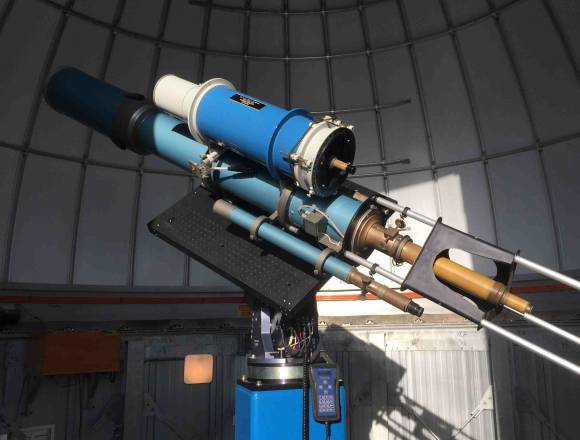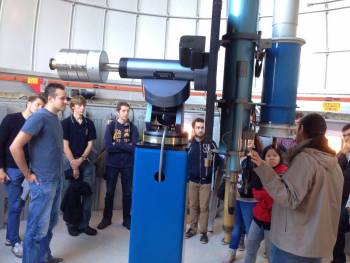Telescopes in Radboud University of Nijmegen
The department of Astronomy at the Radboud University Nijmegen has the following telescopes.
Optical


On the roof of the Faculty of Sciences, there are two domes hosting two telescopes: a historical refractor and a modern catadioptric.
The refractor is 20 cm in diameter and has a focal distance of 208 cm (f/ 10.4). The objective lens is a Littrow doublet, composed of an equiconvex crown glass lens and a second flint glass lens. It is mounted in a commercial equatorial mount Micron GM4000, that can be operated from the manual control and the computer. Also mounted in the same platform there are a finder (a 6cm-diameter refractor with a focal length of 70cm, f/11.6, giving a field of view of 130 arcmin with current eyepiece) and an astrograph (14cm-diameter and focal length 70 cm, f/5).
It is a very special, priceless telescope. The tube and the focusing device, as well as the finder, were built in 1905 by Maurice Manent, and the main lens was built and tested by Dr. André Couder in 1932. It is older than the Waalbrug, the arch bridge over the Waal river inaugurated in 1936, that has become one of the identity signs of the city of Nijmegen. Over a hundred years old, everything is in perfect conditions and fully operative. We use the telescope for solar projection observations, public observations and astrophotography.
The catadioptric telescope is a 14-inch (35.6 cm) diameter Schmidt-Cassegrain with 3.56m-focal distance (f/10), a Meade LX200GPS model. It includes a finder with 53mm-diameter and 8x magnification. It is also mounted in a commercial equatorial mount Micron GM4000, that can be operated from the manual control and the computer. We have a few eyepieces that provide fields of view in the range 12-33 arcmin. We also have a CCD camera with a wheel of filters, model SBIG-ST-10XME, 2184×1472 pix (3.2 Mpix) and ~15×10 arcmin field of view. We use this telescope to teach students how to work with CCD cameras, and for a few science projects. In the summer of 2016, an auto guiding camera and a motor focuser were installed improving the capabilities of the telescope for scientific observations.
The Department of Astrophysics is very committed to outreach activities, as a way to raise awareness in astronomy in general and to inspire students. The Department offers visits to the observatory, open events and stargazing evenings every last Friday of the month as part of our public programme. If you have questions or requests regarding visits to the observatory, please email our Outreach Committee.

Training sessions for the optical telescopes: The optical telescopes can be used by anyone with a valid telescope diploma. First-year students can obtain such a diploma as part of the 'observational astronomy' course, and this diploma is valid for one year. To update the diploma, students need to refresh their diploma by attending one of the official telescope training sessions, held four times a year. Please note that these telescope training sessions are also suitable for department members who want to brush up on their telescope skills. During the session (1:30 - 2:00h) we review how to safely operate the domes and both telescopes, using the manual control and the computer. We setup the 20cm telescope for solar observations, and point the 35cm to the Erasmus building. We also comment on a few interesting facts you can use when guiding people to the telescopes. In addition, and only if there is interest, we show how to use the CCD (extra 01:30h).
Previous training sessions: February 1 2015, April 9 2015, June 16 2015, September 14 2015, February 4 2016, June 29 2016, December 1 2016, June 1 2017.
* Upcoming training session: Week of October 23-27, 2017 - If you are interested in attending the Session, please fill out the following Doddle: Oct Training Doodle*
Telescope users are updated with news and announcements through a
mailing list. All postdocs, PhDs and master students of the Astronomy department are included in this mailing list. Bachelor students with a valid diploma are also included. It is not necessary to have a valid diploma to be able to subscribe to the mailing list. If you want to subscribe/unsubscribe from the mailing list, please send an a email to
Telescope Guardian
Documentation for the optical observatory
If you wish to use the telescopes, it is mandatory to make a reservation. Please use the following links:
Ulrich J. Schwarz Radio Interferometer
Information on the Ulrich J. Schwarz Radio Interferometer can be found here.
Cosmic ray detector
LORA
 LORA (the LOfar Radboud air shower Array) is a cosmic-ray experiment located in the core of LOFAR at Exloo in the Netherlands. The experiment has been built as a part of the LOFAR "cosmic-ray" key-science project.
LORA (the LOfar Radboud air shower Array) is a cosmic-ray experiment located in the core of LOFAR at Exloo in the Netherlands. The experiment has been built as a part of the LOFAR "cosmic-ray" key-science project.
When a cosmic ray enters the earths atmosphere it generates an extensive air shower. The charged particles contained in the air shower mainly the electrons and muons are detected by LORA, consisting of an array of 20 scintillation detectors. LORA can measure air showers initiated by high energy cosmic rays with energies above ~1016 eV.
The main purpose of building LORA is to trigger LOFAR with cosmic-ray events, and to support the analysis of the LOFAR cosmic-ray radio data by providing basic air shower parameters such as the energy and the arrival direction of the primary cosmic ray.
LORUN
LORUN (LOFAR at the Radboud University Nijmegen) was the first prototype cosmic ray detector for LOFAR, placed on the roof of the Huygens Building. It consisted of four protype LOFAR antennae. Electrons contained in an air shower move through the Earth's magnetic field. Due to acceleration by the magnetic field the electrons emit synchrotron radiation which could be detected by LORUN. LORUN was used for the detection of cosmic rays by observing the whole sky in the frequency range 40-80 MHz.







